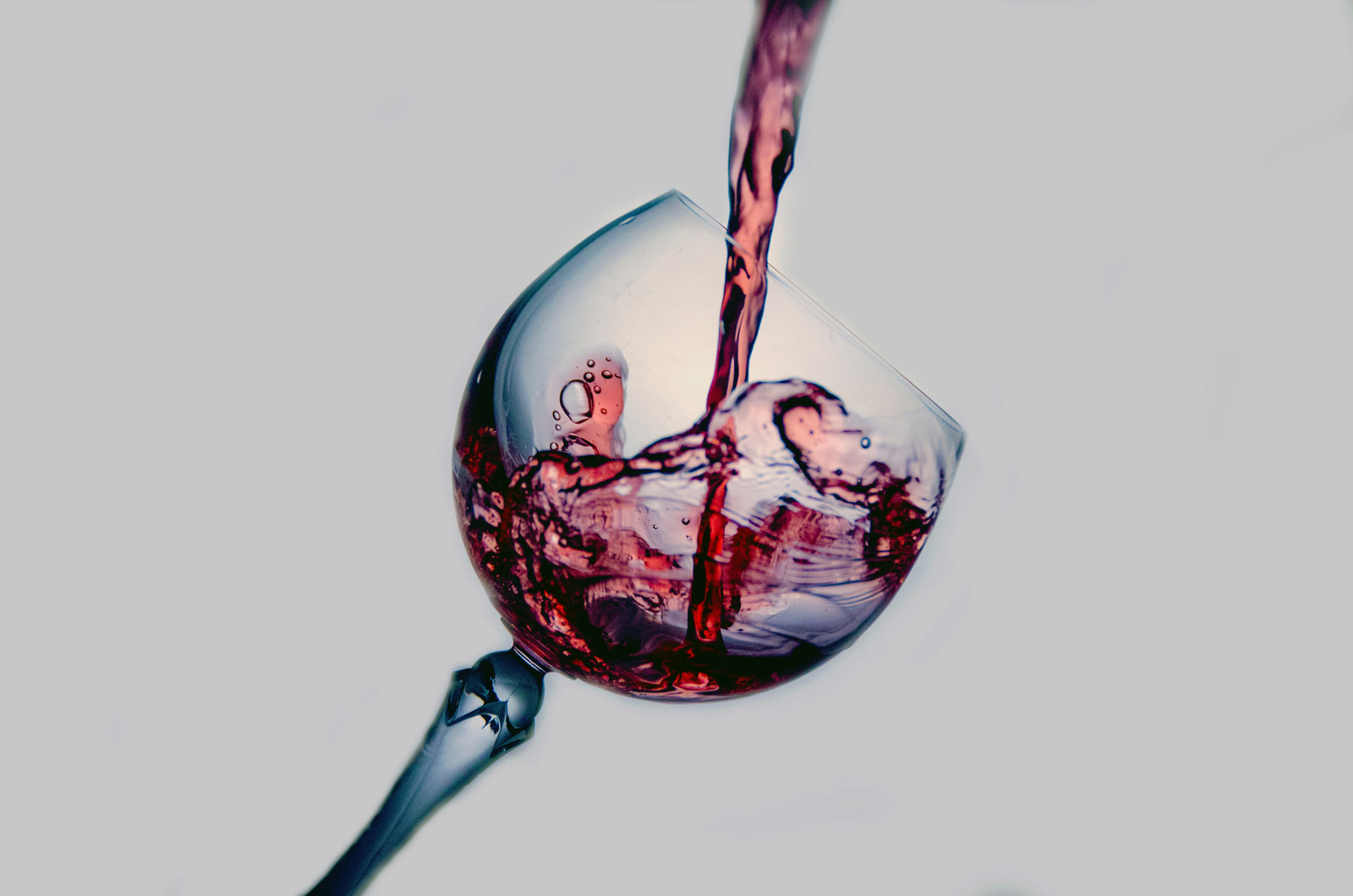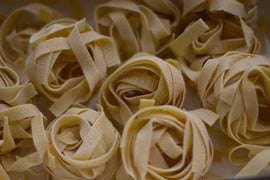If you have ever had fresh oysters with an icy-chilled white wine from Northern Italy, or a lush, rich California Zinfandel to wash down braised lamb shanks with creamy mashed potatoes, then you know how wines can shine when paired with the right foods. Just like with cooking, a finished wine is only as good as the quality of the ingredients being used. Our wines this month are from producers whose specific vision of the type of wine they wanted to produce determined where their fruit should come from, and how their wines should be made. Pair these wines with food and you will wonder where the bottle went. Share them with friends and you will wish there was another bottle to keep the fun going. Better stock up; Summer is here!
Massican - Gemina
Dan Petroski was born and raised in Brooklyn, NY, to an Italian-American family. After attending Columbia University (where he played football) Dan went to work for Time, Inc. While there, he earned his MBA from NYU and worked his way up the ranks towards a promising future in magazine publishing. While enrolled in business school, Dan met a friend who had family in rural Italy. To celebrate their graduation, they took a trip to Italy, where Dan was wowed by Italy’s diversity of culture, food, wine, and history. Years later he returned to Italy, where he helped during harvest at Valle dell’Acate, a Sicilian winery, and then spent six months exploring the country’s various wine regions. Returning to a weak job market in New York, he headed west, where he had received a harvest invitation from Andy Smith at DuMOL Winery that was too good to pass up. After harvest, Andy hired Dan as Cellar Master at Larkmead. The following year, Dan was promoted to Assistant Winemaker, ultimately claiming the Larkmead Winemaker title in 2012. Over his years at Larkmead, Petroski has honed a focused, but ultimately traditional, voice for the estate’s Cabernet Sauvignon. The wines display structure, a commingling of herbs and fruit, and tannins that will allow the wines to improve for decades.
When Petroski arrived at Larkmead, a major vineyard replanting was under way. Among the old vines spared were some Tocai Friulano — a curious white grape grown in Friuli and a holdover from the Italianate days of early Napa Valley. Working with the Larkmead Tocai gave Petroski an idea: What if he could make a noble white blend, in the tradition of the Italian wines he loved, but inject it with California sunshine? “I had in mind a super-Friulian,” he says, like the rich, high-octane, kitchen-sink blends of Friuli’s Vie di Romans.
Dan created Massican in 2009. The name Massican was chosen to honor Dan’s great grandfather who grew up in the foothills of the Monte Massico mountain range north of Naples, in the Campania region. Dan’s timing for starting Massican was very good in that a rare Napa planting of Ribolla Gialla became available in 2009 and formed part of Massican’s first vintage. Dan’s plan was originally to create one wine each year – a blend from his source vineyards. However, after fermenting each varietal on its own he realized he had the components to produce several wines. The focus of Massican’s wines is certainly unique by Napa standards – Dan’s entire production is white wines – and he produces a number of varietals not often seen in Napa. The project brought together a number of Dan’s talents and interests: his love for North Eastern Italy, his business acumen, and his skill as a winemaker. It’s the rare winemaker who can forge a style of wine as original and distinct as Massican while upholding the epitome of the American wine establishment, Napa Valley Cabernet. For this, and for much more, Petroski was named The San Francisco Chronicle’s 2017 Winemaker of the Year.
The 2018 Massican Gemina is a blend of 71% Pinot Grigio coming from the Nichelini Vineyard in Chiles Valley, and 29% Greco coming from the Bowland Vineyard in Russian River Valley. Dave gave the wine a fanciful name, not because he felt it was the "gem" of the portfolio, but for an ancient roman grape planted in the region around Monte Massico. The original name of that grape from Greece was Aminea Gemina; today believed to be the white grape variety Greco. Greco, an Italian grape varietal predominately grown in the region of Campania, is said to be the most tannic of all white grapes. This characteristic gives an interesting, grippy mouthfeel to a normally soft and fruit full Pinot Grigio from Napa Valley. Still bright and fresh, this wine is nicely textured with fruit flavors of green apple, grapefruit, and citrus with a touch of salinity. The pure, clean character of Massican’s Gemina makes it a perfect “food wine”, particularly with delicate seafood preparations and fresh vegetables such as bok choy, English peas, spinach, etc. Try it with spicy Asian fish dishes, roasted pork loin, braised chicken, or rich triple cream cheeses.
2018 Massican Gemina is $25.00/bottle, $270.80/case.
Produttori di Manduria Elegia Primitivo di Manduria DOP Riserva
If you are an Italophile, Puglia has everything you crave in abundance: ancient towns heavy with the tangible past; extravagant churches dreamt up by Europe's finest architects; the footprints of an endless procession of conquerors and cultures, stamped in stone, gold, and marble; seas of olives; olive-green seas; vast stretches of vineyards; and food that can equal any in Italy.
Puglia (a.k.a. Apulia) is located in southeast Italy, or as many describe it, the “heel” of the boot. Flanked by the Adriatic and Ionian seas, it’s a spectacularly fertile peninsula, known for growing olives, figs, almonds, wheat, and of course, wine grapes. Its Mediterranean climate is hot, with long sunny days cooled off by ocean breezes. The region has been inhabited for many centuries, with wines factoring in throughout. The Greeks, Romans, Goths, Lombards, Byzantines, Turks and Venetians all occupied the province at various stages from several centuries B.C. up until 1861, when it was officially recognized as part of Italy.
Puglia is divided into three distinct viticultural zones, each of which is defined by unique terroir and climate. These zones contain dozens of DOCs and are divided regionally from north to south into Foggia, Bari, Taranto, Brindisi and Lecce. In general, the north is much hillier, while the south is relatively flat.
Produttori di Manduria is the oldest active wine cooperative in Puglia. It was first established in 1928 as “Federazione Vini di Manduria” and then converted in to a cooperative in 1932 as “Consorzio Vini e Mosti di Manduria”. Despite being in one of the major wine-producing regions in Italy (Puglia usually ranks 2nd or 3rd in the national ranking in terms of wine produced), Produttori di Manduria is structured and operates like an Alto Adige cooperative, with 400 small growers farming 900 hectares of vineyards. With an average 2.25 hectares per member, each grower is able to carry out most of the vineyard management by hand with an extreme attention to quality. Primitivo represents the major focus of the winery, both in terms of vineyards planted (over 60% of the total) and in terms of tradition. Primitivo is a native variety of Puglia. The name refers to the early ripening nature of this grape. Two main biotypes exist: Primitivo di Manduria and Primitivo of Gioia del Colle (both names of grapes and wines). In most cases, thanks to the high temperature in Puglia during the summer, most producers harvest as early as mid-August. Manduria is considered the birth place of the native Primitivo grape, so much so that in 1974 the Italian Government recognized a specific DOC appellation to the Primitivo made in Manduria. Thanks to this almost symbiotic relationship between Manduria and the Primitivo wine production, the Produttori has always played a vital role in the local economy, becoming the center of Manduria’s economic, social and cultural life. The growers are locally known as the “Masters of Primitivo”, and the membership of the Co-op has been proudly handed down from father to son for generations.
Leonardo Pinto has worked as the consulting winemaker at Produttori di Manduria for over 20 years. He’s considered the “Father of Primitivo di Manduria”, and an authority of this native Apulian grape. Mr Pinto’s focus at Produttori di Manduria is to craft wines that respect Primitivo’s varietal character and that speak of the unique growing conditions in Manduria. He’s constantly helping the growers farm their land in the most environmentally conscious way in order to produce healthy, high-quality grapes.
A genetic similarity has been proven between Apulian Primitivo, Californian Zinfandel, and Croatian Tribidrag. They are all considered biotypes of the same plant. According to most experts, it is likely that Italian immigrants brought this grape from Italy to California during the early 1800 migrations.
Produttori di Manduria’s 2015 Elegia Primitivo di Manduria DOP Riserva is one of the flagship products offered by the winery. It is 100% Primitivo from 35-50 years old, low-yielding vineyards in Manduria, most planted with the “alberello” (small bush) system and thus hand-tended and harvested. The wine is fermented in temp-controlled stainless-steel tanks with a 2-week of maceration on the skins, and aged 12 months in French oak (Allier) barriques. It is then released to the market after an additional 6 months of bottle aging. The 2015 Elegia has opening notes of ripe blackberry and raspberry, followed by intense aromas of plum and cherry jam intermingled with hints of fine spices and eucalyptus. In the mouth, the wine is intense and complex, with flavors of ripe berries (raspberry and blackberry) and plum jam, with balsamic notes at the end. Try it with full-flavored, hearty meat dishes like roasted lamb, beef brisket, hamburgers, meatballs with Moroccan seasonings, beef fajitas, or anything barbecued.
Produttori di Manduria’s 2015 Elegia Primitivo di Manduria DOP Riserva is $27.00/bottle, $291.60/case.





